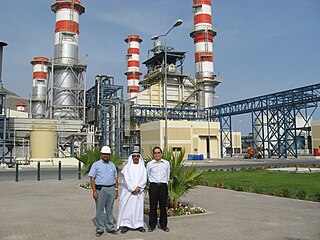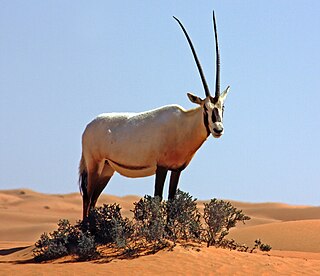
The United Arab Emirates is situated in the Middle East and West Asia, bordering the Gulf of Oman and the Persian Gulf, between Oman and Saudi Arabia; it is at a strategic location along the northern approaches to the Strait of Hormuz, a vital transit point for world crude oil. The UAE lies between 22°50′ and 26° north latitude and between 51° and 56°25′ east longitude. It shares a 19 km (12 mi) border with Qatar on the northwest, a 530 km (330 mi) border with Saudi Arabia on the west, south, and southeast, and a 450 km (280 mi) border with Oman on the southeast and northeast.
Transport in the United Arab Emirates refers to the various forms of transport in the United Arab Emirates (UAE) by road, rail, air, and water.

Al Ain is a city in the Emirate of Abu Dhabi, United Arab Emirates and the seat of the administrative division of the Al Ain Region. The city is bordered to the east by the Omani town of Al-Buraimi. Al Ain is the largest inland city in the Emirates, the fourth-largest city, and the second-largest in the Emirate of Abu Dhabi. The freeways connecting Al Ain, Abu Dhabi, and Dubai form a geographic triangle in the country, each city being roughly 130 kilometres (81 mi) from the others.

The Emirate of Fujairah is one of the seven emirates that make up the United Arab Emirates, the only one of the seven with a coastline solely on the Gulf of Oman and none on the Persian Gulf. Its capital is Fujairah.

Masafi is a village located on the edge of the Hajar Mountains in the United Arab Emirates. It sits at the inland entrance of the Wadi Ham, which runs down to Fujairah City. The border between the emirates of Fujairah and Ras Al Khaimah runs through the town, which houses a barracks used by the United Arab Emirates Armed Forces.
The Dolphin Gas Project is the natural gas project of Qatar, the United Arab Emirates, and Oman. It is the Gulf Cooperation Council's first cross-border refined gas transmission project and the largest energy-related venture ever undertaken in the region.

Fujairah F1 Independent Water and Power Plant or Fujairah F1 IWPP is an independent water and power plant (IWPP) at Qidfa', Fujairah in the United Arab Emirates. It is located next to the Fujairah F2 IWPP. It is 5 kilometres (3.1 mi) south of Khor Fakkan and 20 kilometres (12 mi) north of the city of Fujairah. When constructed, the Fujairah plant was the first hybrid plant in the Middle East, and the largest desalination hybrid plant in the world.
Fujairah F2 Independent Water and Power Plant or Fujairah F2 IWPP is an independent water and power plant (IWPP) at Qidfa', Fujairah in the United Arab Emirates. It is located next to the Fujairah F1 IWPP plant south of Khor Fakkan and north of the city of Fujairah. During inauguration, it was the largest desalination plant in the United Arab Emirates.

Dibba Al-Hisn is a pene-exclave of the emirate of Al-Sharjah, one of the seven United Arab Emirates. It is bordered by the Gulf of Oman from the East, Dibba Al-Baya from the North, and Dibba Al-Fujairah from the South. It is also geographically part of the Dibba region. It is the smallest in size among the Dibbas. It is mostly known for its fish market and the ancient fortress from which it got its name. Also, it is known for its high density of population relative to the other Dibbas.

Wadi Wurayah is a 12,700-hectare (31,000-acre) wadi between the towns of Masafi, Khor Fakkan, and Bidiyah in the United Arab Emirates. It has been designated as Ramsar Wetland of International Importance.The lush canyon in the area was named after the tall marsh plant known as ‘warrah’, that flourishes in its wetlands, while the word ‘wadi’ is the Arabic term for valley.
The three cities of Abu Dhabi Emirate within the United Arab Emirates – the coastal city Abu Dhabi itself as well as the inland oases Al Ain and Liwa – receive their drinking water supply entirely from desalinated seawater.

While being a major oil producing country, the United Arab Emirates (UAE) has taken steps to introduce solar power on a large scale. However, solar power still accounts for a small share of energy production in the country. The country was the 6th top carbon dioxide emitter per capita in the world in 2009, with 40.31 tonnes, but is planning to generate half of its electrical energy by 2050 from solar and nuclear sources, targeting 44% renewables, 38% gas, 12% coal, and 6% nuclear energy sources.

The wildlife of theUnited Arab Emirates is the flora and fauna of the country on the eastern side of the Arabian Peninsula and the southern end of the Persian Gulf. The country offers a variety of habitats for wildlife including the coast, offshore islands, mangrove areas, mudflats, salt pans, sand and gravel plains, sand dunes, mountain slopes, wadis and rocky summits. Because the terrain is so varied, it supports a greater number of species of plants and animals than might be expected in a small country.

Environmental issues in the United Arab Emirates (UAE) are caused by the exploitation of natural resources, rapid population growth, and high energy demand. The continuing temperature rise caused by global warming contributes to UAE's water scarcity, drought, rising sea level, and aridity. The UAE has a hot desert climate, which is very vulnerable to the effects of climate change and contributes to worsening water scarcity, quality, and water contamination.

Fujairah City is the capital of the emirate of Fujairah in the United Arab Emirates. It is the seventh-largest city in UAE, located on the Gulf of Oman. It is the only Emirati capital city on the UAE's east coast. The city of Fujairah is an industrial and commercial hub located on the west coast of the Indian Ocean that sits at the foothills of the Hajar Mountains.

Fujairah Museum is an archaeology and local history museum located in Fujairah City, Emirate of Fujairah, United Arab Emirates.

The Sheikh Zayed Mosque, Fujairah, is the main mosque in the Emirate of Fujairah, and the second largest in the U.A.E. after the mosque with the same name in Abu Dhabi.

Hamad Bin Abdulla Road is the main road running east–west through Fujairah City, Emirate of Fujairah, United Arab Emirates.
Port of Fujairah, also called Fujairah Port, is a deep port located in Fujairah, United Arab Emirates. It is the largest port on the eastern seaboard of the United Arab Emirates and the world second largest bunkering hub.














